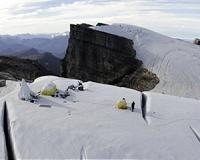| . |  |
. |
San Diego CA (SPX) Jul 16, 2010 Glaciers that lose their footing on the seafloor and begin floating behave very erratically, according to a new study led by a Scripps Institution of Oceanography, UC San Diego researcher. Floating glaciers produce larger icebergs than their grounded cousins and do so at unpredictable intervals, according to Scripps glaciologist Fabian Walter and colleagues in a paper to be published in the journal Geophysical Research Letters. This study presents the first detailed observation of the transition from grounded to floating glaciers. Such a transition is currently taking place at Columbia Glacier, one of Alaska's many tidewater glaciers. Tidewater glaciers flow directly into the ocean, ending at a cliff in the sea, where icebergs are formed. Prior to this study, Alaskan tidewater glaciers were believed to be exclusively "grounded" (resting on the ocean floor), and unable to float without disintegrating. However, Columbia Glacier unexpectedly developed a floating extension in 2007 that has endured far longer than researchers expected. The research team believes that this floating section may have been caused by the speed at which the glacier is receding. Columbia is one of the fastest receding glaciers in the world, having retreated 4 kilometers (2.49 miles) since 2004, and nearly 20 kilometers (12.43 miles) since 1980. "We're seeing more tidewater glaciers retreat," Walter said. "As they retreat, they thin and that increases the likelihood that they'll come afloat." The study, co-authored by U.S. Geological Survey (USGS) glaciologist and Scripps alumnus Shad O'Neel, is part of a larger effort to understand and include calving in large-scale glacier models, which are essential in producing accurate forecasts of sea-level rise. The research team conducted its study on Columbia Glacier by installing a seismometer, a sensor that measures seismic waves that are produced by shifts in geologic formations, including earthquakes, landslides, and glacier calving. They studied data collected from 2004-2005 and 2008-2009 that allowed them to compare the glacier's activity before and after it began floating. The formation of icebergs, through a process known as "calving," is a leading source of additional water for the global ocean basin. As this study confirms, grounded glaciers and floating glaciers often show fundamentally different calving mechanics. However, iceberg calving is also one of the least understood processes involved in ice mass loss and consequential sea level rise. This study, which is funded by the National Science Foundation, sheds light on the process by comparing the size and frequency of icebergs calved by a glacier during both floating and grounded conditions. Calving occurs when fractures in the ice join up and cause a piece of ice to completely separate from the main glacier to form an iceberg. Unlike the floating glaciers, grounded glaciers calve icebergs nearly continuously, but they are generally quite small. Through this study, scientists can begin to analyze the mechanics of the calving process in glaciers (both floating and grounded) and ice shelves, which will allow them to better understand and predict iceberg production from glaciers and ice sheets. These predictions, in turn, will provide a more accurate estimate of sea-level rise in the coming years. As of the date of this press release, the paper is still "in press" (i.e. not yet published). Journalists and public information officers of educational and scientific institutions who have registered with the American Geophysical Union can download a PDF copy of this paper in press.
Share This Article With Planet Earth
Related Links Scripps Institution of Oceanography Beyond the Ice Age
 US scientist in race to learn from Indonesia's dying glacier
US scientist in race to learn from Indonesia's dying glacierJakarta (AFP) July 2, 2010 The only glacier in the western Pacific could disappear in less than five years, taking with it vital clues about the earth's changing climate, a US scientist said Friday. Ohio State University Professor Lonnie Thompson has just completed what he calls a "salvage mission" to extract ice cores from the glacier on Punjak Jaya, which soars above the tropical, reef-fringed waters of eastern Indo ... read more |
|
| The content herein, unless otherwise known to be public domain, are Copyright 1995-2010 - SpaceDaily. AFP and UPI Wire Stories are copyright Agence France-Presse and United Press International. ESA Portal Reports are copyright European Space Agency. All NASA sourced material is public domain. Additional copyrights may apply in whole or part to other bona fide parties. Advertising does not imply endorsement,agreement or approval of any opinions, statements or information provided by SpaceDaily on any Web page published or hosted by SpaceDaily. Privacy Statement |